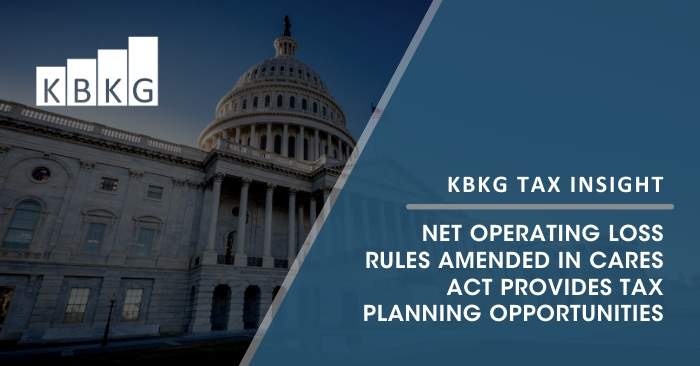For the most up-to-date information on Qualified Improvement Property, see our latest post.
Under the new Coronavirus Aid, Relief, and Economic Security Act (CARES Act), net operating losses (NOLs) which are generated in 2018, 2019, or 2020 can now be carried back five years. The CARES Act also repeals the 80% income limitation for NOL carryovers that can be deducted in tax years beginning before January 1, 2021. Clients in a current NOL position now have a reason to accelerate deductions to recoup taxes paid as far back as 2013.
KBKG Insight: Congress has provided taxpayers a much-needed source to access cash through tax refunds in this economically sensitive period. Taxpayers should immediately consider all opportunities to generate losses such as cost segregation studies, accelerating the depreciation of misclassified Qualified Improvement Property (QIP), Sec. 179D energy efficient building deductions, international transfer pricing corrections, reviewing current and prior year capital expenditures for retirements dispositions or repair deductions, missed bonus depreciation, and a number of other available accounting method changes.
Prior to the CARES Act, the Tax Cuts and Jobs Act (TCJA) and other legislation severely constrained the ability to use net operating losses to lower tax liabilities. TCJA restricted carrybacks of NOLs generated in tax years after December 31, 2017 and limited carryforwards to 80% of taxable income.
The CARES Act modified Section 172 of the Internal Revenue Code to allow NOLs generated in tax years beginning after December 31, 2017 and before January 1, 2021 to be carried back to each of the five preceding taxable years. Businesses that paid federal income taxes in 2013 to 2017 may be able to claim a tax refund as a result of 2018, 2019 or 2020 NOLs. Procedurally NOLs are carried back to the earliest of their 5-year period and then to subsequent tax years. But taxpayers may elect to forgo the 5-year carryback and simply carry NOLs forward.
KBKG Insight: Deductions are more valuable in prior years when tax rates were higher. A $100,000 loss generated in 2019 by a corporation and carried back to offset 2016 income can result in up to a $35,000 tax refund ($100,000 x 35%). Carrybacks are also more valuable than carryforwards because of the time value of money (tax savings are worth more today than in future years).
In addition to the 5-year carryback, the CARES Act suspends the 80% limit on carryforwards, allowing NOLs to fully offset taxable income until the end of 2020.
KBKG Insight: An NOL carryback can also free up unclaimed federal tax credits and other tax attributes from closed tax years. If the NOL carryback results in credits no longer being used in the closed year, these items are eligible to be carried forward. In addition, if credits or other tax attributes were missed on the original return (e.g. unclaimed Research Tax Credit), the taxpayer may determine the unclaimed credits in the closed year and carry them forward without having to amend returns. For more information on this strategy, see KBKG’s post: Adjusting Tax Credits and NOL Carryforwards in a Year Closed by the Statute of Limitations.
KBKG Case Study: A taxpayer could have but did not claim $100,000 of research tax credits in each year including 2014 and 2015. They paid $120,000 of tax ($343,000 of income at a 35% tax rate) in each year including 2014, 2015, and 2016. They generate $686,000 of NOLs in 2019 through a cost segregation study. Without the new NOL carryback provision, it does not make sense to calculate missed credits from 2014 or 2015 because they would have been used against taxes paid in those closed tax years. However, the new 5-year NOL carryback wipes out taxes from 2014 and 2015 generating a $240,000 refund. Now the missed 2014 and 2015 research credits ($200,000) will carry forward to 2016, which is an open tax year that can be amended. This allows for an additional refund of $120,000 of 2016 tax paid with the remaining $80,000 of research credits carrying forward.
Further relief provided in the CARES Act allow taxpayers whose 2017 fiscal tax period began before December 31, 2017 to carryback their loses generated during that period. Taxpayers in this situation must timely file a carryback claim or make an election to forgo the carryback no later than 120 days after the enactment of the CARES Act.
The calculation of NOLs for tax years beginning in 2019 and 2020 may be greater as a result of changes in the CARES Act to Section 163(j). The changes allow taxpayers to increase their business interest expense deduction based on a higher percentage of adjusted taxable income (ATI). For tax years beginning in 2020, the CARES Act also allows taxpayers to substitute their 2020 ATI with 2019 ATI if it results in a more favorable NOL calculation.
For multinational companies, corrections to transfer pricing may allow companies to generate additional tax US NOLs to carryback to prior years. Multinationals would be well served by reviewing taxes payable and tax NOL positions in each country where they operate. Intercompany pricing changes can often help companies optimize cashflow by reducing taxes payable on a global basis.
Forthcoming guidance is expected to clarify how taxpayers will claim the NOL carrybacks. Despite the changes to the rules concerning NOLs the past couple of years, there is some precedent of the current situation that may provide insight into what taxpayers can expect.
KBKG Insight: Rev. Proc. 2009-19 and Rev. Proc. 2009-52 discuss similar NOL provisions and the IRS Forms used to claim refunds.
Contact a KBKG specialist to discuss options on how to maximize tax deductions or the effects on credits calculated in prior years. Our team is available to discuss the new CARES Act and how it may impact your tax situation.
Authors: Gian Pazzia; Sumit Sharma; Winston Shurtz
Source:
Coronavirus Aid, Relief, 3 and Economic Security Act


